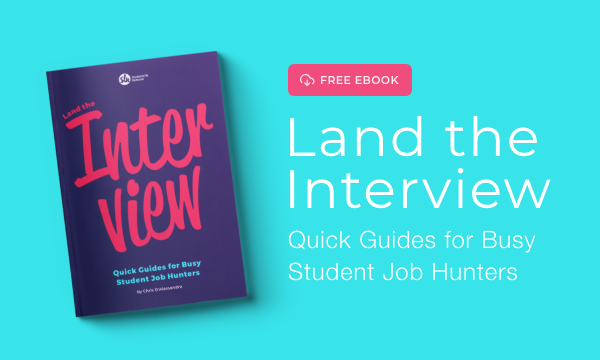Want to learn more about building your network and landing a job interview at your dream company? Our free ebook can help.
Chris Ackroyd is just another good Canadian kid from a small town.
He grew up loving hockey. And he wasn’t quite sure what he wanted to do when he graduated university.
But he did know one thing. He wanted to work in hockey.
A few coffees and a few years later, Chris is a Manager of Content and Social Communications at the NHL.
Chris landed a gig working for his dream company. And he did it using some simple networking tools.
Here’s how he did it.
(Psst. We totally forgot to put Chris’ Twitter handle in the podcast. But you can follow him here.)
“It’s not what you know, it’s who you know.”
We can argue whether or not that statement is true all day.
What’s important is that having relationships with people inside companies can help you in a number of ways:
→ You can get put on a shortlist for an open position.
→ You can learn about your industry and what might be holding you back from being a more appealing candidate.
→ They may recommend you for a position within their network where you would be a good fit.
But what if you don’t know anyone inside a company you want to work for? Are you screwed?
Not by a long shot.
Your network isn’t fixed.
You’re in charge of reaching out to people, of asking for introductions, and connecting with people that you believe you can build mutually beneficial bonds with.
Let’s get something straight. Networking does not mean:
→ Just showing up to events.
→ Having, forced awkward conversations with strangers.
→ Talking yourself up to impress someone.
→ Simply exchanging information.
You should view networking as a series of daily interactions that build your own unique community.
Your community should consist of people whom you:
→ Seek advice and provide advice openly.
→ Perform and ask for favours from.
→ Take turns buying a round with—both metaphorically and literally.
Remember, every interaction is an opportunity. And true networking is making friends and figuring out how you can help them.
How do you meet these people?
Really hope you read that in a Seinfeld voice.
Can we establish one super important thing right away?
You really shouldn’t ever cold call anybody on the phone or walk into an office without setting up a meeting first.
We can’t tell you how many recruiters have told us that they absolutely hate when candidates do this.
So please, don’t do it. Ever.
Start doing some research, and create a list of people you want to meet.
Find the people who have the job you want.
Use LinkedIn, Twitter or Ten Thousand Coffees to connect with people you:
→ Admire.
→ Think you gain great insights from.
→ With whom relationships down the road end may up being useful to both of you.
Will each one of those people get you an interview? Probably not, and that shouldn’t be the only goal you have.
You should meet with people to find out more about your industry.
And we’re going to tell you exactly how to do that.
How do you find people’s emails?
The first thing you might try is using common email conventions that will exist at companies (ex. firstname.lastname@company.com).
But that’s not always a surefire trick.
So next you might try to see if they have a “Contact” page on their personal website.
You can also try finding them on Twitter, and sending them a direct message asking if it might be okay if you reached out via email.
If you’re really at a loss, you can try using plugins like Rapportive, and tools like RocketReach. But keep in mind, those “freemium” services that will start to charge you for more connections and looks ups.
Your best bet is to stick to LinkedIn, because even a direct email can get lost in the shuffle and more often than not, easily dismissed.
Establishing a relationship in 2 steps.
Step 1: Reach out via email.
You can search for people in your industry via LinkedIn.
Do your research on them—see if they’ve written a blog for example, see if you can find out what projects they’ve worked on
Start by sending one email to someone you think you could learn from.
Ask them if they would be willing to do you a small favour by sharing some of their time or insights.
Taking this first step really serves as a reminder that the world isn’t so scary, and people generally are happy to help—when asked.
Over time, one conversation leads to another, and, as though you’re picking up momentum on monkey bars, you’ll find that even if you only tackle a single challenge or conversation at a time, you can travel distances you once thought impossible.
Include links to your LinkedIn profile and personal website to make it easy for someone to research you.
Steal this template:
Hey [person I’m interested in connecting with],
I thoroughly enjoyed [something they’ve done recently—perhaps a talk, project or published article]. The part about [find something about their work that you’re sincerely interested in] really resonated with me because [again, be sincere].
I was wondering if I could take you out for coffee in the coming week and pick your brain for 30 minutes about [a genuine inquiry you have about your chosen industry], among other career-related topics.
Are you free on any of the following dates?
[OPTION 1]
[OPTION 2]
[OPTION 3]
If none of those work, kindly suggest an alternative and I’d be happy to move my schedule around to accommodate yours.
Cheers,
[your name]
[your contact info]
[your website]
For example:
Hey Bruce,
I thoroughly enjoyed your talk on crime-fighting in Gotham last night. The part about Arkham being under-resourced really resonated with me because I’m completing my internship there and have experienced it first-hand.
I was wondering if I could buy you a coffee in the coming week and pick your brains for 30 minutes about a problematic patient I’m dealing with, among other career-related topics.
Are you free on any of the following dates?
Thursday, Nov 1
Wednesday, Nov 7
Friday, Nov 23
If none of those work, kindly suggest an alternative and I’d be happy to move my schedule around to accommodate yours.
Cheers,
Harley Q.
Drquinzel.wordpress.com
Step 2: Meet up.
So you’ve made a new friend, perhaps via email, a phone call, or maybe even at an industry event.
What’s next? The crucial in-person meeting is next.
This is the interaction that transforms an encounter into a relationship.
Reaching out to meet up for coffee (or tea, not everyone is a coffee drinker) shows that you’re serious about your desire to learn from someone else, and the second, deeper and more specific meeting is what truly establishes what will hopefully become an ongoing relationship.
Ask your new connection:
→ What books they’re reading or podcasts they’re listening to.
→ Who are they inspired by, who their mentors are.
→ Why they got into their industry.
→ How they got into their current role.
→ What challenges they face on a day to day.
→ How is their industry changing?
→ What they think you should be working on if you want to break into the industry.
Be prepared to talk about:
→ Why you reached out to that person specifically.
→ Why you’re passionate about their industry.
→ What you’re currently working on.
General rules:
→ Be honest and straightforward with your ask.
→ But don’t ever, ever ask for a job flat out. Ever.
→ Showcase your honest passion for something beyond just a job.
Also, ask if they would be willing to critique your work or portfolio. An honest review from a trusted mentor can go a long way
Finally, As a good practice, ask your contact who else you think could provide you some valuable insight. Figure out who you should reach out to next.
How to Land a Job Interview, The Book
Struggling to a land a job interview?
Our free ebook will teach you about personal branding, networking and how recruiters decide who to interview.
Did we mention it’s free?
*Opinions expressed are those of the author, and not necessarily those of Student Life Network or their partners.





